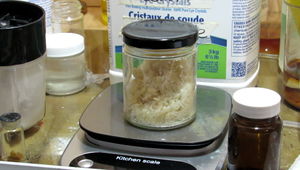Difference between revisions of "Acetamide"
(Created page with "{{Chembox | Name = Acetamide | Reference = | IUPACName = Acetamide | PIN = | SystematicName = Ethanamide | OtherNames = <!-- Images --> | ImageFile = | ImageSize = | ImageA...") |
|||
| (2 intermediate revisions by the same user not shown) | |||
| Line 7: | Line 7: | ||
| OtherNames = | | OtherNames = | ||
<!-- Images --> | <!-- Images --> | ||
| − | | ImageFile = | + | | ImageFile = Acetamide prepared product by TheCanadianChemist.jpg |
| − | | ImageSize = | + | | ImageSize = 300 |
| ImageAlt = | | ImageAlt = | ||
| ImageName = | | ImageName = | ||
| + | | ImageCaption = Freshly prepared acetamide in a jar | ||
| ImageFile1 = | | ImageFile1 = | ||
| ImageSize1 = | | ImageSize1 = | ||
| Line 65: | Line 66: | ||
| pKb = | | pKb = | ||
| Solubility = 200 g/100 ml | | Solubility = 200 g/100 ml | ||
| − | | SolubleOther = Soluble in [[benzene]], [[chloroform]], [[ethanol]], [[glycerol]], [[methanol]], [[pyridine]]<br>Slightly soluble in [[diethyl ether]], [[toluene]] | + | | SolubleOther = Soluble in [[benzene]], [[chloroform]], [[ethanol]], [[glycerol]], [[isopropanol]], [[methanol]], [[pyridine]]<br>Slightly soluble in [[diethyl ether]], [[toluene]] |
| Solubility1 = 50 g/100 ml | | Solubility1 = 50 g/100 ml | ||
| Solvent1 = ethanol | | Solvent1 = ethanol | ||
| Line 111: | Line 112: | ||
}} | }} | ||
}} | }} | ||
| − | '''Acetamide''' or '''ethanamide''' is an organic compound with the formula '''CH<sub>3</sub>CONH<sub>2</sub>'''. It is the simplest [[amide]] derived from [[acetic acid]]. | + | '''Acetamide''' or '''ethanamide''' is an organic compound with the chemical formula '''CH<sub>3</sub>CONH<sub>2</sub>'''. It is the simplest [[amide]] derived from [[acetic acid]]. |
==Properties== | ==Properties== | ||
| Line 125: | Line 126: | ||
==Preparation== | ==Preparation== | ||
Acetamide can be produced in the laboratory by dehydrating [[ammonium acetate]]. | Acetamide can be produced in the laboratory by dehydrating [[ammonium acetate]]. | ||
| + | |||
| + | A simpler route involves refluxing [[urea]] with glacial [[acetic acid]].<ref>https://www.youtube.com/watch?v=J4oDTWYqNwI</ref> | ||
Ammonolysis of [[ethyl acetate]] is also another route. | Ammonolysis of [[ethyl acetate]] is also another route. | ||
| Line 138: | Line 141: | ||
===Storage=== | ===Storage=== | ||
| − | + | Acetamide should be kept in closed glass or PE bottles. | |
===Disposal=== | ===Disposal=== | ||
Latest revision as of 18:21, 29 February 2020
 Freshly prepared acetamide in a jar
| |
| Names | |
|---|---|
| IUPAC name
Acetamide
| |
| Systematic IUPAC name
Ethanamide | |
| Properties | |
| C2H5NO | |
| Molar mass | 59.068 g/mol |
| Appearance | Colorless solid |
| Odor | Odorless (pure) "Mouse"-like (impure) |
| Density | 1.159 g/cm3 (20 °C) |
| Melting point | 81.16 °C (178.09 °F; 354.31 K) |
| Boiling point | 221.2 °C (430.2 °F; 494.3 K) (decomposes) |
| 200 g/100 ml | |
| Solubility | Soluble in benzene, chloroform, ethanol, glycerol, isopropanol, methanol, pyridine Slightly soluble in diethyl ether, toluene |
| Solubility in ethanol | 50 g/100 ml |
| Solubility in pyridine | 16.6 g/100 ml |
| Vapor pressure | 0.0182 mmHg at 25 °C |
| Hazards | |
| Safety data sheet | Sigma-Aldrich |
| Flash point | 126 °C (259 °F; 399 K) |
| Lethal dose or concentration (LD, LC): | |
| LD50 (Median dose)
|
7,000 mg/kg (rat, oral) |
| Related compounds | |
| Related compounds
|
Formamide |
| Except where otherwise noted, data are given for materials in their standard state (at 25 °C [77 °F], 100 kPa). | |
| Infobox references | |
Acetamide or ethanamide is an organic compound with the chemical formula CH3CONH2. It is the simplest amide derived from acetic acid.
Contents
Properties
Chemical
Dehydration of acetamide in the presence of catalyst yields acetonitrile.
Physical
Acetamide is a colorless solid, very soluble in water.
Availability
It is sold by chemical suppliers.
Preparation
Acetamide can be produced in the laboratory by dehydrating ammonium acetate.
A simpler route involves refluxing urea with glacial acetic acid.[1]
Ammonolysis of ethyl acetate is also another route.
Alternatively acetamide can be obtained in excellent yield via ammonolysis of acetylacetone under conditions commonly used in reductive amination.
Projects
- Make acetonitrile
Handling
Safety
Acetamide doesn't appear to be very toxic.
Storage
Acetamide should be kept in closed glass or PE bottles.
Disposal
Can be neutralized with a strong oxidizing mixture.